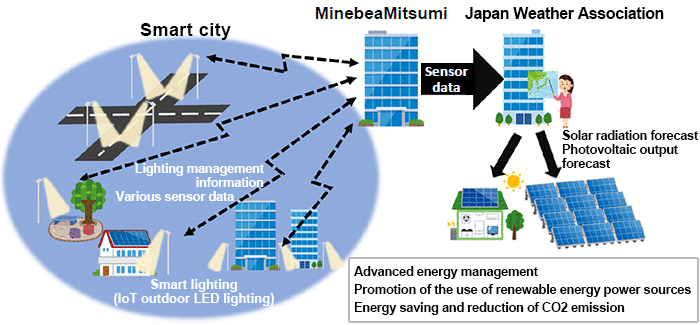Japan Weather Association and MinebeaMitsumi Launch New Initiative
The Japan Weather Association and MinebeaMitsumi Inc. are working together to improve the accuracy of weather forecasts by utilizing smart lighting*1 data. Continuing this initiative from FY2020, we started a new demonstration experiment for improving the accuracy of solar radiation and photovoltaic output forecasting. We will expand the subject areas of the demonstration experiment during this fiscal year and will examine the results from September 2021 to March 2022.
Outline of demonstration experiment
As one of the initiatives in which the JWA and MinebeaMitsumi collaborate, carrying on from FY2020, we will conduct a demonstration experiment tentatively entitled “an empirical investigation for improving the solar radiation forecasting (FY2021)” from September 2021 to March 2022. This project was commissioned by Mitsubishi Research Institute, Inc., the leading operator that is conducting “FY2021 Consignment Business for a Survey Examining the Shift to Outdoor Smart Lighting and Zero Emissions,” publicly solicited by Ministry of the Environment, Government of Japan.
In a demonstration experiment conducted under the same framework as in FY2020,*2 we used data obtained from smart lighting that combines high-efficiency LED street lights with a wireless function (Photo 1) and various sensors originally developed by MinebeaMitsumi to verify the possibility of improving the accuracy of solar radiation forecasting. The results showed a certain improvement effect in accuracy by using the obtained sensing data in solar radiation forecasting.
In this demonstration experiment, we will continue our initiative from FY2020 and examine the sophistication of the formula for converting from illuminance data obtained through smart lighting to solar radiation with a longer observation period, thereby verifying the effectiveness of solar radiation estimation and the possibility of replacing existing solar radiation meters. In addition, with the cooperation of 2 local governments, we will conduct region-wide observation of solar radiation or illuminance at several points throughout the area and utilize the obtained sensing data in solar radiation forecasting to verify the improvement effect on prediction accuracy.

Background
In order to achieve carbon neutrality by 2050, Japan is promoting the shift to renewable energy sources that do not emit CO2 for its mainstay power sources. For photovoltaic power in particular, which is progressively introduced in recent years, the output fluctuates greatly depending on the weather. Therefore, in order to achieve a stable balance of power supply and demand, it is necessary to predict the amount of power generated in advance and with high accuracy. Accurate weather forecasting is assumed to be essential to this kind of prediction.
Additionally, “Smart Lighting” is an outdoor lighting technology that incorporates IoT technologies into street lights owned by local governments. This technology saves energy and reduces CO2 emissions by using LEDs and by adjusting lighting according to the surrounding environment. Smart lighting is regarded as one of the energy optimization initiatives for smart cities*3, and is expected to be widely used by local governments. We expect that real-time analysis of the sensor information of this smart lighting will enable utilization in various applications, such as improving the prediction accuracy of weather information.
Purpose of Cooperation
We aim to develop new smart city solutions by combining the JWA’s advanced weather forecasting technologies and the smart lighting that MinebeaMitsumi is preparing to introduce.
The JWA has developed its own highly precise weather forecasting technologies. By utilizing smart lighting data from smart cities in these technologies, we expect to further improve prediction accuracy.
MinebeaMitsumi has also developed its own smart lighting as a smart city solution. This smart lighting enables not only lighting management but also real-time collection of temperature, illuminance, and other data from the attached sensors. Widespread use of smart lighting in a smart city enables the collection of detailed yet region-wide sensor data for the smart city.
Through these initiatives, the JWA and MinebeaMitsumi will contribute to the realization of smart cities and Society 5.0*4, which enable advanced energy management.

*1: Smart lighting
An outdoor lighting technology incorporating IoT technologies into street lights owned by local governments.
*2: An FY2020 demonstration experiment.
October 29, 2020: Press Release
Japan Weather Association and MinebeaMitsumi Aim to Improve Prediction Accuracy of Weather Information by Utilizing Smart Lighting Data – Conducting a demonstration experiment in collaboration for the development of new smart city solutions
*3: Smart city
A sustainable city or district where management (planning, maintenance, administration/operation, etc.) is carried out by utilizing new technologies such as ICT in the aim of overall optimization and to solve various urban issues.
*4: Society 5.0
A future society following the information society (Society 4.0), proposed in the 5th Science and Technology Basic Plan drafted by the Government of Japan.
Next Story


